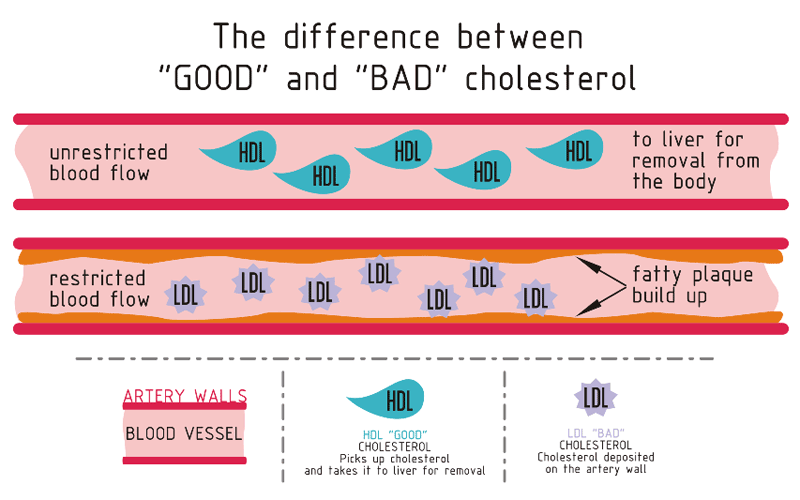How To Read A Cholesterol Blood Test?
When you receive your Cholesterol blood test results, you may want to know how to read it and what is the normal Cholesterol level in blood, and how to raise it to a good amount. There are many recommendations which help to find out the normal Cholesterol level and how to adjust it. The overall level of Cholesterol in blood is the measurement of bad Cholesterol components (low- density lipoprotein) and the level of good Cholesterol (High-density lipoprotein). Cholesterol is considered a fatty substance which exists in blood and is produced naturally by the body. 75% of the Cholesterol amount has been observed to exist in liver and other cells and it is considered a required part of the digestive system. Cholesterol is found in various food groups such as meat steaks, full-fat milk and eggs.
Good Cholesterol And Bad Cholesterol.
Cholesterol is found in two different forms which are high-density lipoprotein and low-density lipoprotein. Good Cholesterol (HDL) is considered healthier since it prevents the accumulation of lipids on the walls of arteries. On the other hand, it is well known that bad Cholesterol (LDL) does the opposite which leads to the accumulation of lipids on the walls of arteries and it may lead to clogged arteries.
Richard Melanie (PHD in Medicine and American heart association) states that bad Cholesterol may clog any part of the body and when the arteries which feed the heart are clogged, this will result in heart attacks. Additionally, when the arteries which feed the brain are clogged, this will result in apoplexy. Finally, when the arteries which feed the legs are clogged, this leads to walking difficulty. Hence, maintaining good Cholesterol levels is a great method to keep a healthy heart and lower the chances of apoplexy and in order to do so, one must identify with Cholesterol numbers in blood.
American heart association recommends adults at the age of 20 or more to get a Cholesterol blood test every 4-6 years and to display the charts to find out Cholesterol level. The test presents a report which shows Cholesterol levels in each Mg\DL in blood. Reading Cholesterol levels in blood and other medical factors can predict risks which threaten your life.
The report of Cholesterol test in each MG\DL in blood will clarify how levels of Cholesterol affect the risk of heart diseases and the physician will take into consideration a group of factors such as age, family history, smoking and high blood pressure.
Types of Cholesterol in blood:

Good Cholesterol (HDL):
High-density lipoprotein consists of 50% protein and 20% Cholesterol which aids in disposing excessive and bad Cholesterol in body in the form of bile. Moreover, it has extremely high benefits to the body. According to American heart association, individuals who have 60 MG\DL of HDL are unlikely to get heart diseases.
Bad Cholesterol (LDL):
This is low-density lipoprotein which consists of 25% protein and 45% Cholesterol. It exists in different areas of the body and occasionally, it precipitate on the walls of arteries and when the precipitation percentage increases, it heightens the risk of blood clots, heart attacks, apoplexy and clogged arteries. According to National institutes of health, the perfect level of LDL is less than 100 MG\DL and in the case of high LDL levels which rise above 130 MG, the individual will need treatment.
Triglyceride:

Triglyceride is considered the form which exists in most lipids in food. The increase of Triglyceride in related to the risk of heart diseases and coronary artery diseases. The details are as follows:
Triglyceride Levels:
- Less than 150 is considered a normal level.
- 150-199 and above is considered a medium level.
- 200-499 is considered a high level.
- 500 and above is considered an extremely high level.
Total Cholesterol:
It is important to understand when an individual needs to perform a Cholesterol blood test and when it is possible to repeat it.
- Every 5 years if the individual’s age is between 40-75 years.
- Every 12 months if the individual is trying to lower the Cholesterol level in blood via medication.
- Any child less than 10 years of age who suffers from genetic high cholesterol level.
What Are The Required Procedures To Perform Cholesterol Blood Test?
A Cholesterol blood test should be executed by health care employees and other agencies which have received enough training. It is necessary to take a blood sample safely to receive the test percentage correctly. It is a must that the body is well-hydrated before performing the test.
What Are The Results That I Expect To See?
The test results should be read well in order to understand the possible risks that could happen. The numbers may not imply a serious matter and it is definite that there are a minimum percentage of the values presented in Cholesterol test. Cholesterol levels are measured by MMOL\ Liter and in some countries it is measured by MG\DL. The guiding principles to reading Cholesterol levels are as follows:
- Total Cholesterol (TC): It is the total percentage of Cholesterol in blood and the perfect level should be 5 MMOL\LITER or less.
- Good Cholesterol (HDL): It is the total percentage of good Cholesterol and the perfect level should be 4 MMOL\LITER or less.
- Bad Cholesterol (LDL): It is the total percentage of bad Cholesterol and the perfect level should be 3 MMOL\ LITER.
Percentages Of Bad Cholesterol Levels:
- Less than 100 MG\DL is the perfect level.
- Between 100\129 Mg\DL is the perfect lower level.
- Between 130-159 MG\DL is considered a high level.
- Between 160-189 MG\DL is considered a high level.
- Above 190 is considered an extremely high level.
The Percentage Of Good Cholesterol Levels:
- Less than 40 MG\DL is considered a risk of suffering heart diseases.
- Between 40-59 MG\DL is considered a better level.
- 60 MG\DL is considered a preventive level which protect from heart diseases.
What Are The Factors which Affect The Cholesterol Levels In Blood?
There are various groups of factors which affect Cholesterol level in blood and most of us include them in our daily routine. These factors are as follows:
Diet:

Saturated fats and Cholesterol exist in foods which we occasionally eat and they subsequently result in high Cholesterol level in blood. It is advisable to change your diet and to avoid a dietary system which contains high percentage of saturated fats. The easiest method to reduce saturated fats in your diet is to decrease the consumption of animal products such as meat, eggs and dairy products. Elimination of saturated fats in your diet will help in boosting good Cholesterol level.
Weight:
Good Cholesterol level in blood could be raised through losing excessive weight. Studies have shown that obesity and overweight are related to low good Cholesterol level in blood. When you lose the extra weight, it will reduce the percentage of lipids in your dietary system and raise your activity levels.
Exercising:

In addition to following a healthy dietary system, it is considered that the best method to raise good Cholesterol levels is to exercise daily for a period between 20 to 30 minutes per session. This will help to raise good Cholesterol level. These exercises include running, swimming and cycling.




Awesome Blog. Very much enjoyed reading.